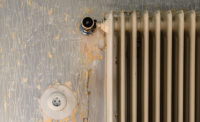Dan Holohan: The subtlety of steam
Help your customer be a better troubleshooter.

You may think steam is just, well, steam. But there’s a lot more going on when it comes to steam heating a building. A bit of knowledge about the hot stuff will make you a better troubleshooter when it comes to what’s heating many of our older buildings. So let me help you look like a genius.
Let’s begin with liquid water. Take a pound of it (that’s about a pint), put it on the stove and heat it from 32° liquid (yes, water can be liquid at that temperature) to 212° liquid. The odd thing about water is that it is the only substance on earth that can exist in three states (solid, liquid and gas). And it does some funny things with temperature along the way.
Consider this: To get that 32° to 212° rise in temperature you will need to apply 180 Btu because one Btu will raise one pound of water one degree on Gabriel Fahrenheit’s scale. But once there, you still don’t have steam. What you have is very hot liquid water. To get the liquid excited enough to change state into a gas (what we call steam in this case) you have to add an additional 970 Btu to that single pound of water. That’s more than five times the heat it took to get from 32° to 212°. When it becomes steam, the temperature is still 212°.
And that pound of steam is now 1,700 times larger than it was when it was liquid water. That’s what makes it move out of the boiler and head for the radiators.
But is this good steam? Is it the sort that will do a good job of heating the radiators and making the people smile? Is it dry steam? Or is it wet steam?
Did you know there were two types of steam? Yes, there’s wet steam, and then there’s dry steam. Take your pick. But before you do, consider this: Back in the day, we were all about the dry steam. Steam boilers were voluminous and had had large steam chests. That’s the hydronic auditorium above the boiler’s waterline, the place where escaping steam gathers and leaves behind the liquid water. Those older boilers also had wide sections, which allowed the steam to be polite as it rose through the liquid water toward the steam chest. Hey, no shoving allowed here!
And since the sections were wide, the exit holes cast into the sections could also be wide. That was great because those wide exit doorways to the supply pipes kept the steam’s velocity down. If the steam goes too fast as it leaves the boiler, it will tornado-suck the liquid water right out of the boiler. That gives birth to wet steam, which is steam that contains more than 2% liquid water. It’s tough to heat a building with this sloppy stuff because the steam wants to condense in the liquid water it’s dragging along rather than in the radiators. You wind up burning lots of fuel and the building won’t heat well.
The boiler manufacturers of old used to test for dry steam, and they wouldn’t give a boiler their seal of approval if it couldn’t produce steam with less than 2% liquid water. But then the OPEC oil embargo arrived in 1973 and brought with it high fuel prices. Steam boiler manufacturers, in an attempt to make their boilers more efficient, reduced the size of their boilers dramatically. That led to narrower boiler sections, cramped steam chests, choked exit holes, much higher steam velocities and very wet steam.
This created all sorts of problems in the field. None of the boilers could pass the dry-steam test during the 1980s, so the manufacturers quietly stopped testing for dry steam, which was good for them because you can’t fail a test you’re not taking.
So there.
But there’s a bright side to this. In place of the dry-steam test, the manufacturers gave us really good near-boiler piping instructions. If the new boilers couldn’t get the water out of the steam internally, the near-boiler piping would have to do the job externally. It became the installer’s responsibility to pipe the boiler in such a way that the near-boiler piping would separate the liquid water from the steam as it left the boiler. Pipe it properly and it would work. Ignore the installation instructions and it wouldn’t.
The onus was now totally on the contractor. And some contractors don’t like to read instructions. They continued to pipe steam boilers as they always had, but the boilers had changed. Their habits hadn’t. Lots of callbacks followed.
When it comes to replacing a steam boiler these days, there is nothing more important than piping it properly and in full accordance with the manufacturer’s instructions. If corners get cut, wet steam will result, and wet steam leads to water hammer, uneven heating, high fuel bills and miserable customers who will hate everyone involved in the job.
But following instructions is a choice.
Please make the right one.
Oh, and I should also mention that there’s a third type of steam we call superheated steam, and no, it doesn’t wear a cape. This is the steam that runs turbines and makes power. It’s under very high pressure and it’s hotter than it’s supposed to be. Industrial folks make that magic happen by running normal, dry steam through a super heater, where it picks up more heat than it should be holding in the real world. This causes the steam to become absolutely, positively dry, and that keeps the turbine happy. Imagine a very large turbine spinning at 3,600 RPM. Toss some non-compressible liquid water in there and watch what happens. And then run!
Superheated steam can cool as it passes through the turbine without turning to water. We don’t use superheated steam for heating because saturated steam, which is always in equilibrium with liquid water at that same temperature, has a higher useful heat content. You can see all of this on a Saturated Steam Table, should the spirit move you, but unless you’re doing industrial work, just keep it in mind as an interesting factoid.
Oh, and those who work in power plants where there is always very high-pressure steam will often hold a corn broom in front of themselves as they walk among the pipes. These plants are very noisy and you can’t see high-pressure steam leaks. They are as invisible as the air. You can see the corn broom’s bristles disappear as you walk, however. And that’s the signal that makes those who work in power plants stop walking. Keep going and your torso will look like the poor corn broom.
Always be careful no matter what when it comes to steam. And know that dry steam is what we’re always after. If you go a bit beyond the boiler manufacturer’s installation instructions you’ll get even better results. Here’s what I mean:
- Use all the risers out of the boiler to the header. If the manufacturers says use one, use two. You’ll cut the steam’s exit velocity in half and get drier steam. Boiler manufacturers compete with each other, and if one says their steam boiler will work well with one riser to the header, the competitor will be reluctant to recommend two risers for their boiler, even though we all know that physics rules. Use as many risers as you can and the steam will slow down and dry out.
- Increase the size of the header. The larger the header is, the lower the steam velocity will be, and that’s good for everyone involved. The steam will leave the boiler very quickly; that’s a given these days. A larger-than-required header will slow it down and give the carryover water a chance to drop back into the boiler rather than up into the system piping.
- Use a drop-header. This is where you come out of your boiler with risers as high as you can before turning through two elbows to drop into your horizontal steam header at a lower level. The rise out of the boiler will leave much of the water behind. Drop-headers work wonders when it comes to quieting the system and lowering the fuel bills.
Stay dry!
Looking for a reprint of this article?
From high-res PDFs to custom plaques, order your copy today!





